Aircraft Diesel Piston Engine Options

The Zoche Diesel: Like the little red train in the children’s story that makes it to the mountain top first despite ridicule by the bigger, supposedly more powerful trains, the Zoche radial diesel aircraft engine may soon be huffing and puffing its way past its traditional aviation engine competitors.
Zoche has recently announced that its line of lightweight, fuel-efficient, two-stroke, radial diesel powerplants have made it to the production phase.
Design Persistence Pays
But it has been an uphill climb. Designed and developed by Michael Zoche and company in Munchen Germany, the Zoche Aero Diesel has been much belittled by advocates of traditional gasoline-fueled aircraft piston engines.
The engine was theoretically so far ahead of its competition that cynics wrote the effort off as just another fantasy engine. But who could blame them?
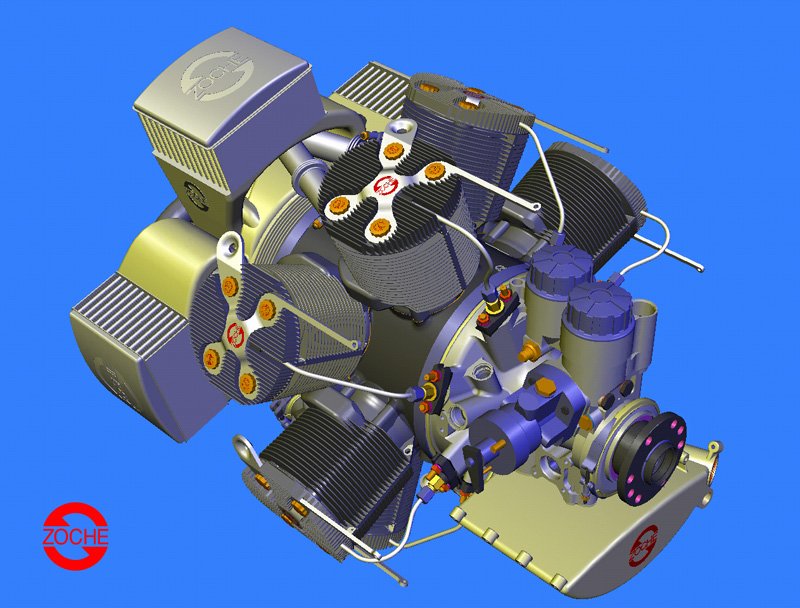
The eight-cylinder, two-stroke Zoche Z0-02A diesel is the largest of the Zoche engine line and will be the first to fly in a Westinghouse airship.
This was an era when other wonder engines were bursting on the aviation scene with much fanfare but just as quickly disappearing — never making the transition from design drawings to working hardware.
Just a few years ago there was even a persistent rumor that the Zoche Diesel engine had encountered insurmountable technical problems forcing the Zoche family to begin again with a variant design. The common thought was that the Zoche bubble had finally burst.
The four-cylinder Zoche Aero Diesel Z0-03A will weigh 185 pounds and put out 150 hp, according to the company.
But the Zoches pressed on with dogged determination and no small amount of technical expertise and creativity. In recent years, the number of Zoche engine models increased from two to three, and within the sport aviation community the interest in the project did not wane.
Now, at long last, the incredible Zoche Diesel engine is in production (1995). The most complex engine of the three, the eight-cylinder Model Z0-02A, using quantity production components, was first run during the week of January 16 – 1995.
The Zoche Diesel Specifics
In addition to the models already developed— the 300-hp Z0-02A and the 150-hp, four-cylinder Z0-03A—the Zoches have recently added a 70-hp, two-cylinder ZO-01A. These power ratings are constant to 9000 feet, according to the company.
All three models are direct-drive, boosted, air-cooled, two-stroke, radial diesels, and the specifications for the group of powerplants reveal them to be extremely powerful for their weight and size.
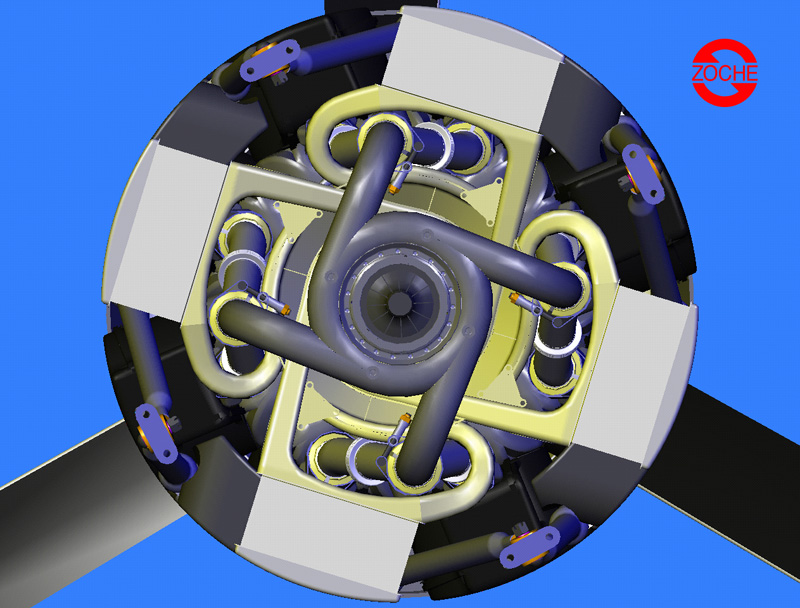
The Zoche Diesel engines are apparently also very efficient. Their rated specific fuel consumption — 0.356 lb./hp/hour — is 25% lower than current aircraft engines.
Thus operating costs will be relatively low. Being able to burn cheap fuel will also help keep fuel costs down. This exceptionally high efficiency also contributes to the reduction of the amount of rejected heat and the parallel requirement for cooling air.
These numbers project the Zoche Diesel engines as being far superior to their contemporaries in every category. According to Zoche, engine prices will be competitive with current certificated aircraft engines.
Zoche Diesel – A Bright Future
In spite of the apparent leap frogging of powerplant state-of-the-art, the Zoche’s have placed great emphasis on reducing the parts count to simplify manufacturing and improve reliability. The initial TBO is projected at 2000 hours. If the Zoche engines perform as planned, they will be well received by pilots.
The engines use just a single power lever—there is no mixture control, no alternate air, no mag switch, no mandatory temperature, no boost or power restrictions and no threat of carburetor ice or vapor lock. A fully automatic pre-lubrication system makes cold-weather starts a breeze.
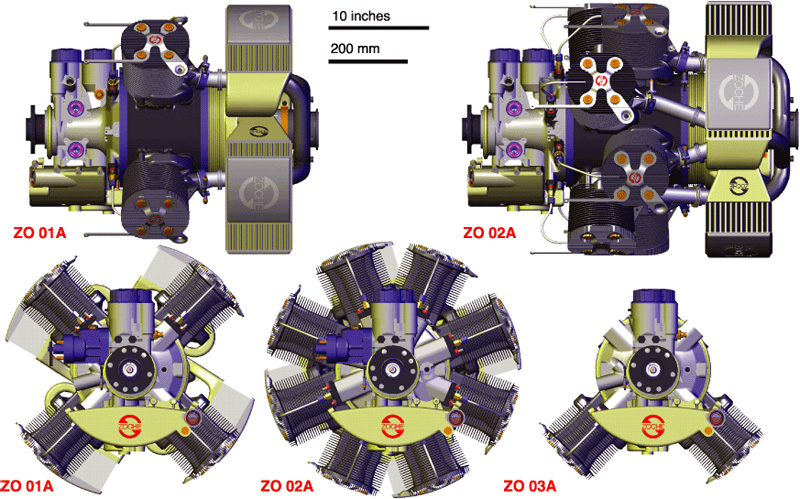
Also contributing to a pleasant flying environment is the relative quietness of the engine. In addition to accurate balancing, torque vibration is minimized because there is only one power pulse per revolution.
Also, the boost system incorporates a turbocharger that reduces exhaust noise. The Zoche Diesel eight-cylinder Z0-02A is slated to have its first flight in a Westinghouse airship later this year.
The same engine will make its first fixed-wing flight in a Extra 300 late in 1995. Availability of Zoche engines, as well as European certification to JAR-E and U.S. certification to FAR 33, is expected later this year.
Like the little train in the story, the Zoche Diesel engines are proof positive that significant obstacles can be over-come with a lot of hard work and more than a little confidence.
| Figure 1 | ||
|---|---|---|
| Power-to-Weight Comparison | ||
| Engine Model | Power (hp) | Weight (lb.) |
| Z0-02A | 300 | 271 |
| Cont. TS10-520 | 310 | 490 |
| Z0-01A | 150 | 185 |
| Lyc. 0-320 | 150 | 280 |
| Z0-03A | 70 | 121 |
| Cont. 0-200 | 100 | 245 |
| Notes: All Zoche power numbers are constant to 9000 feet; All weights are for similarly equipped engines. | ||
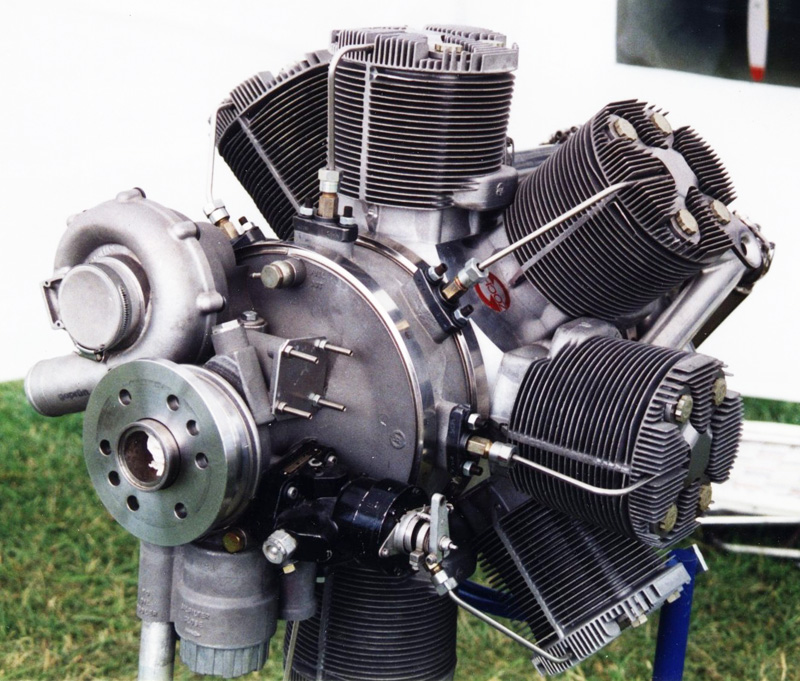
| Figure 2 | |||
|---|---|---|---|
| Engine-Size Comparison | |||
| Engine Model | Length (inches) | Width (inches) | Height (inches) |
| Z0-02A | 36.8 | 25.4 | 25.4 |
| Cont. TS10-520 | 42.6 | 42.5 | 33.5 |
| Z0-01A | 32.4 | 21.8 | 21.8 |
| Lyc. 0-320 | 29.6 | 32.2 | 23.0 |
| Z0-03A | 29.5 | 21.8 | 15.9 |
| Cont. 0-200 | 28.5 | 31.5 | 23.2 |
| Notes: All Zoche power numbers are constant to 9000 feet; All weights are for similarly equipped engines. | |||
IS THERE A DIESEL IN YOUR FUTURE?
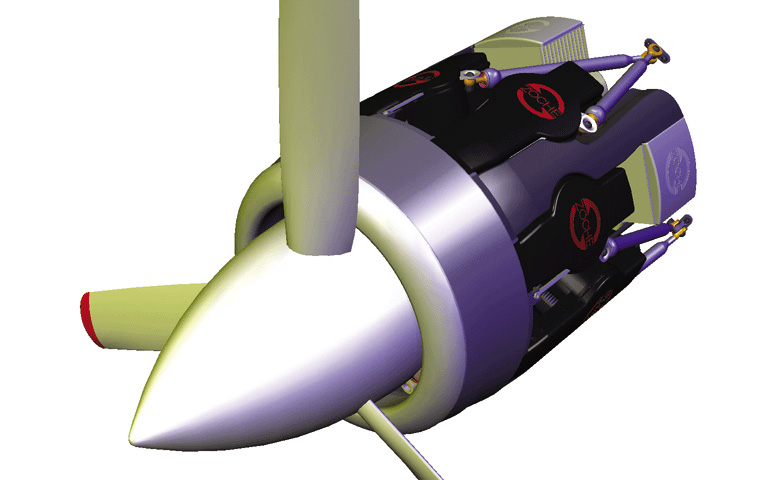
HOW DOES THE PROSPECT OF BEING ABLE TO BUY HIGH-POWERED, LIGHTWEIGHT ULTRA-RELIABLE, CERTIFIED DIESEL ENGINES SOUND TO YOU?
Dick Camille – February 1993
The many pilots who have seen them at Oshkosh for the past few years have been immediately taken with the radial diesel engines of Zoche Aero-Diesels of Munchen, Germany.
These patented two-stroke, four – and eight-cylinder diesel engines may be the future of light power applications. If they are ever certified, they just may be the low-cost, reliable engines we’ve needed for our training fleets and personal aircraft.
The basic engine is a four-cylinder radial to which another bank can be added bringing the total hp to 300, and the weight to a low, low, 259 pounds. Though two-stroke engines are not new to experimental aircraft, they are real strangers to certified aircraft.
For a variety of reasons, two-stroke engines have never made it to the big time, but all of that is about to change because of developments recently announced in Australia and in Detroit. It seems that the automobile industry is trying to whittle their costs once again and still remain within the legal boundaries for pollution and performance.
Henry Ford figured out years ago that if it wasn’t on the car it wouldn’t cost anything and it couldn’t break, and two-stroke engines are very parts-efficient. Other than a crankshaft, connecting rod, and piston, they have precious few moving parts.
There are no valves, no push rods or valve lifters, no cam shaft, no cam chain or belt. All the accessories needed are spark plugs, distributor, coil, condenser, or an electronic CDI (capacitor discharge ignition) system.
As aircraft homebuilders and ultralight enthusiasts have long known, despite the engine’s relative simplicity, a two-stroke powerplant has an excellent power-to-weight ratio, especially when it is allowed to wind up to its full power potential.
The two-stroke engine is truly the essence of internal combustion simplicity. Automobile engineers in Australia have recently realized the promise of the two-stroke (though non-diesel) engine, and they’ve gone to work to modernize the design.
Using high-tech design, including computer-controlled fuel and oil injection, they came up with a small engine which puts out less pollution than a standard four-stroke automotive engine with all of the pollution controls and gadgets on it.
Detroit has been involved in the R&D on this project for some time now, hoping that the research might lead to a two-stroke engine they could install in a very small car with an even smaller price tag, yet one which will deliver to today’s motorists the performance they demand from their automobiles.
The basic Zoche engine is a four-cylinder, two-stroke diesel radial. For aircraft applications, another bank can be added to bring the unit’s total hp to 300.
Though still outsiders in automotive and aircraft manufacturing, two-stroke engines are widely used for other, mostly smaller, applications today.
They are used in chainsaws, leaf blowers, and larger radio-controlled model aircraft. Over the years I have had considerable experience converting large two-stroke engines to diesel with outstanding results.
The result of the addition of a diesel head to a two-stoke engine is an immediate power increase of between 20 to 25 percent. Concurrently, the torque of engine goes way up too, making it possible for the motor to swing a much larger propeller than before.
Fuel consumption is cut in half and cooling is tremendously improved. Another advantage is that the engines became very tolerant of mixture changes and require almost no resetting of the carburetor as altitude or humidity changes.
Increases in density altitude are almost indiscernible and no leaning is required. And since nearly every airport of any size has JP-4, finding fuel for the diesel should be a lot easier and a lot cheaper.
Zoche Aero-Diesels of Munchen, Germany, has plans to certify their potentially revolutionary two-stroke radial diesel engines. A prototype was on display at Oshkosh this past summer, and it attracted large crowds of homebuilders curious about the design and its possible applications.
Among the many other benefits of diesels is their immunity to carburetor-ice and vapor-lock problems. In fact, temperatures are so low that inlet monitoring is no longer necessary. The exhaust manifold temperature is about 720 degrees lower than that of comparable gasoline engines.
Moreover, the composition of diesel fuel is such that it has a much lower flammability which dramatically reduces the fire hazard. Even the electronics benefit, because there is no electrical magnetic interference, because there are no spark plugs generating radio signals.
Due to the high torque of diesel engines there is no need for a propeller reduction unit (as is common on two-stroke aircraft engines), the lack of which reduces the weight of the unit and once again reduces the parts and part failure rates. Maintenance costs are also less because of the much fewer parts and the extra ruggedness of diesel components.
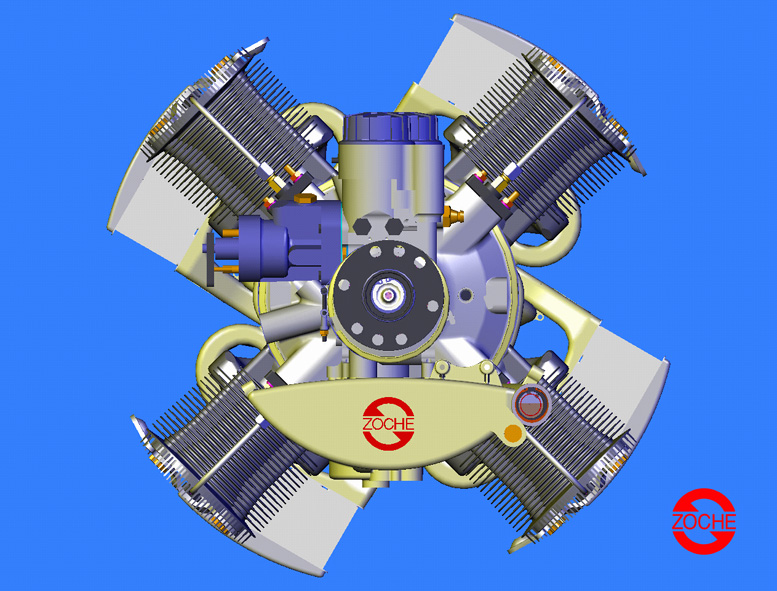
The Zoche Aero-Diesel has an added advantage of being a perfectly balanced engine with power strokes arranged so that there are overlapping power strokes per revolution. All parts are carefully balanced for added smoothness.
Starting a diesel requires a different technique. Truck and auto diesels use glow plugs to help ignite the mixture until the engine warms up. They are then shut down and the engine operates on its own heat built-up in the cylinders.
Diesels are known as compression ignition engines, which means that, as the cylinder comes to the top the mixture is squeezed to a pressure where it heats up and explodes without the benefit of a spark plug or glow plug.
Generally speaking, diesel engines cost less to make, weigh less, are simpler and cheaper to manufacture, and use less expensive fuel than gasoline engines. If Zoche’s diesel engines do indeed reach the market, look for these and other advantages to be strong selling points for the design.
Timing of a diesel engine is controlled by the compression ratio that is arrived at during the design process. In a smaller, model-aircraft-type engine, starting is facilitated by the addition of a compression screw on top of the cylinder.
Using this screw, compression can be increased until the engine starts, at which time the compression can be decreased until the engine is running smoothly. The Zoche unit is started by the use of compressed air. Using a patented pneumatic start system which provides instant manifold pressure, the engine can start cold and accelerate to 2500 rpm within a second.
The air tank is refilled after every start by a manifold-air-driven free-piston pump. In case it is needed, this pump can be operated on any two barometric (28 psi) air supply. There is a starting tank aboard, though any standard air supply can do the job.
The Zoche engine has a power pad running at crankshaft speed at the rear of the engine which operates a direct drive, overload protected, brushless alternator unit. Also on this power pad are the pneumatic starter, prop governor, and turbocharger.
The fuel injection pump together with the feed pump, the fuel filter, and all connecting plumbing, is also built into the crankcase assembly. The intake manifold is also built into the crankcase casting. Once again, fewer parts means less maintenance and more reliability.
Zoche is currently starting the certification process under JAR-E and FAR 33. Patents are held in Europe, the United States, and Japan and the company has registered their “Aero-diesel” trademark. The company expects the price for one of these engines to be comparable to that of a Lycoming or Continental of similar power. There are some problems with diesel engines, however.
First and foremost is the simple fact that pilots are traditionalists and are very slow to accept any change from the norm, even when its a change for the better. Diesel fuel smells bad and if you get any on your hands or clothing during refueling operations it is with you for a long time, just like cheap perfume.
The radial design is also a shortcoming for the Zoche engine. Radial engines aren’t common on modern aircraft, partly because they present a larger profile and more drag than sleek-cowled horizontally-opposed engines.
In aircraft designed for high cruise speeds, a radial engine is a real liability. Other aircraft, built for their hauling or climbing ability, such as the Wilga Classic 80, should be able to make excellent use of a radial.
As for helicopters, since in most designs the engine is buried behind the cockpit of the craft, the shape of the engine would not have any significance, and its light weight, great torque and exceptional reliability should make it a natural for the rotary wing market. What may wind up hurting this fine engine is the cost.
If it were 50 percent or even 70 percent of the cost of a traditional four-stroke, horizontally-opposed Lycoming or Continental, then it would probably have a much greater chance of success. Pilots know and trust the old standards, and it’s going to take some incentive to get them to make any big change. A significantly lower cost might be just such an incentive.
As Zoche is proclaiming so loudly and, in our opinion, so rightly, two-stroke diesels make an awful lot of sense as aircraft engines. Even if Zoche fails at the game, and we hope they don’t, look for two-stokes to eventually emerge on the scene anyway.
The Austrian two-stroke auto car engine we mentioned earlier, for instance, would be a natural for a diesel conversion. If a high-quality dieselized aircraft version of this engine were to come out, it could become the engine of choice for homebuilts and other lightweight aircraft.
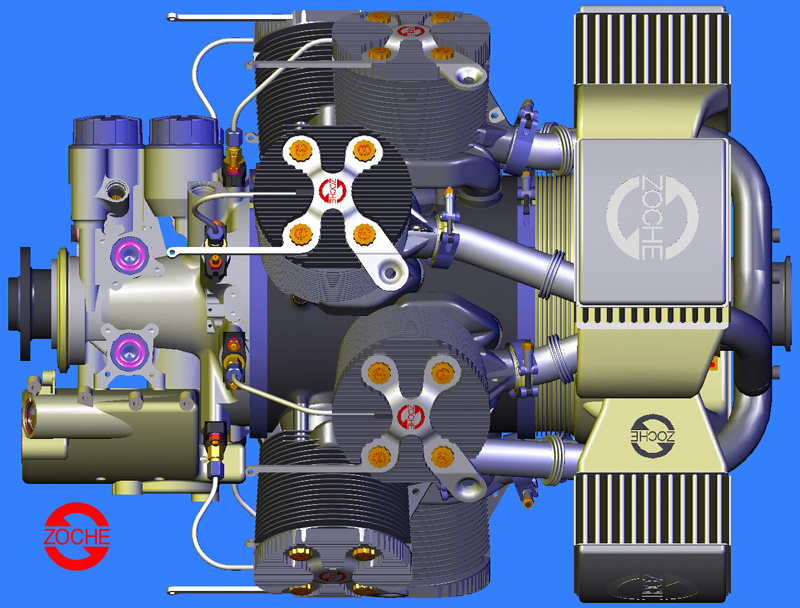
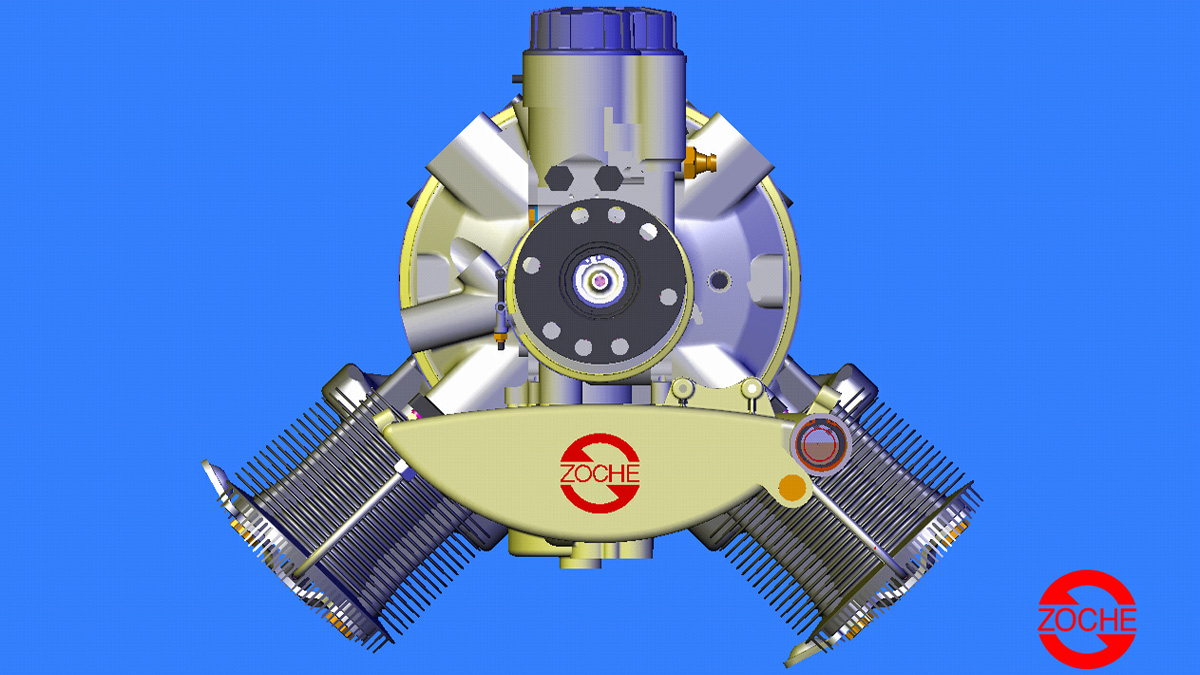

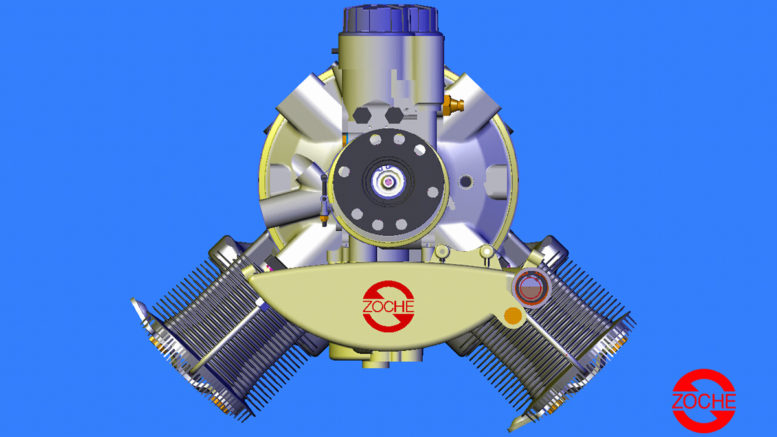
Hi,
Is Zoch 03A MOTOR IN PRODUCTION?
Regards,
Israel H. Ha
Unfortunately the engine is not currently available to the public. The status of the company is also unknown.
I would like to see this engine in production(8 cyl). Once all the issues of the engines are sorted I hoping that a 400 hp version can be produced. Also I would like a counter rotating engine available. I have done a comparison with other aircraft and a 7 seat 3 wing aircraft using these engines has surprising performance.
I first saw Zoche way back in the last years of the past century, like
’98 or so.. they were talking of certification in a ‘few’ years then, and they are still saying this now.. maybe someone else should take the idea into the air?
Uncertified 150HP is way to go Rotec in Australia make radials so a manufacturer with experience is available!
The Zoche has a design flaw in that it would require external pressure to start it is not capable of using crank case transfer pressure as cylinders do not displace case volume. So it must require a external pressure to inject air into cylinder for start and idle. The only video I have ever seen of a Zoche running has 3 or 4 very quick start and stops. i believe that this is because of an air receiver that is storing excess boost for the purpose of starting and will soon bleed to atmosphere.